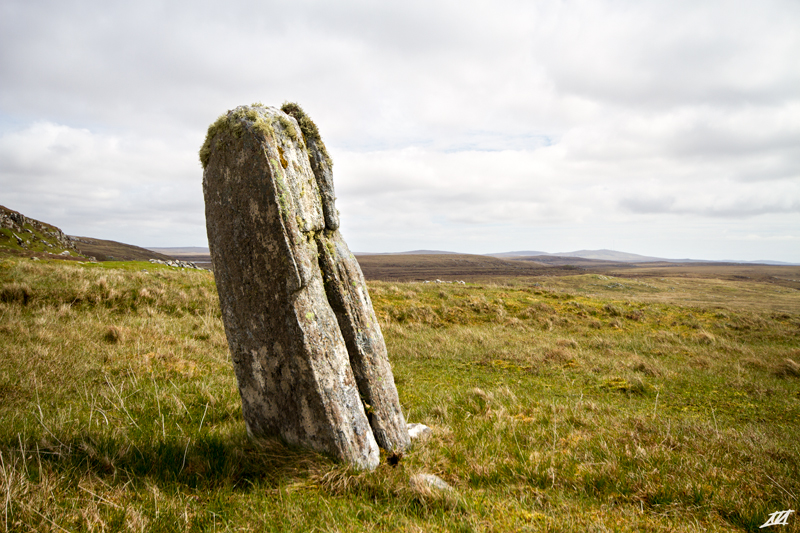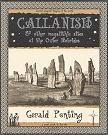<< Our Photo Pages >> Callanish 11 - Standing Stone (Menhir) in Scotland in Isle of Lewis
Submitted by Gerald_Ponting on Friday, 07 February 2020 Page Views: 12621
Neolithic and Bronze AgeSite Name: Callanish 11 Alternative Name: Airigh na Beinne Bige, Callanish XICountry: Scotland County: Isle of Lewis Type: Standing Stone (Menhir)
Nearest Town: Stornoway Nearest Village: Breasclete
Map Ref: NB22233569 Landranger Map Number: 8
Latitude: 58.222084N Longitude: 6.732531W
Condition:
| 5 | Perfect |
| 4 | Almost Perfect |
| 3 | Reasonable but with some damage |
| 2 | Ruined but still recognisable as an ancient site |
| 1 | Pretty much destroyed, possibly visible as crop marks |
| 0 | No data. |
| -1 | Completely destroyed |
| 5 | Superb |
| 4 | Good |
| 3 | Ordinary |
| 2 | Not Good |
| 1 | Awful |
| 0 | No data. |
| 5 | Can be driven to, probably with disabled access |
| 4 | Short walk on a footpath |
| 3 | Requiring a bit more of a walk |
| 2 | A long walk |
| 1 | In the middle of nowhere, a nightmare to find |
| 0 | No data. |
| 5 | co-ordinates taken by GPS or official recorded co-ordinates |
| 4 | co-ordinates scaled from a detailed map |
| 3 | co-ordinates scaled from a bad map |
| 2 | co-ordinates of the nearest village |
| 1 | co-ordinates of the nearest town |
| 0 | no data |
Internal Links:
External Links:

Gerald Ponting writes: The single standing stone has long been known to the people of Breasclete. Surprisingly, it had never been recorded in any archaeological literature. All the information known about this site was gathered by Margaret Pontinq, Ron Curtis and myself.
Local tradition records that this site has been used, perhaps for generations as a source of suitable slabs for use as door lintels for black houses. A piece of metal embedded in a crack in the erect stone tends to confirm this - the result of an unsuccessful attempt to split the remaining stone. The stones were sometimes taken to the village on sledges in winter. There is even a tale of regular hauntings at one house due to the of fending "Druidical" lintel; which continued till the occupier emigrated!
Initially, we thought that the site was the remains of a large circle. Having found about twenty possible features it was clear that the site was not a circle.
Latterly, Margaret and I suggested that it could be a southward facing "observatory" site (to match the predominantly north facing observatory of site V?).
The features near the cliff represent observing positions and the features at the lower edge of the terrace act as markers for horizon positions.
Remarkably, all the other sites in the "Callanish Complex" are visible from this site, with the exception of site VIII - and this was "marked" by site XV, which would have been visible when erect. XI. XV and VIII are in a straight line.
Access: In Breasclete village take the Pentland road towards the moors. Immediately beyond the first cattle grid, leave the road and climb steeply up the hill on the left for about five minutes.
Text reused with permission from "The Stones around Callanish" by Gerald Ponting and Margaret Ponting (now Margaret Curtis).
Gerald Ponting's web site
Canmore site no. 4151.
Note: Geophysical survey finds evidence of a stone circle at this standing stone site in the Calanias complex, and possibly an ancient lightning strike at the site - more in the comments on our page
You may be viewing yesterday's version of this page. To see the most up to date information please register for a free account.
Do not use the above information on other web sites or publications without permission of the contributor.
Nearby Images from Geograph Britain and Ireland:

©2018(licence)

©2010(licence)

©2010(licence)

©2007(licence)

©2013(licence)
The above images may not be of the site on this page, they are loaded from Geograph.
Please Submit an Image of this site or go out and take one for us!
Click here to see more info for this site
Nearby sites
Key: Red: member's photo, Blue: 3rd party photo, Yellow: other image, Green: no photo - please go there and take one, Grey: site destroyed
Download sites to:
KML (Google Earth)
GPX (GPS waypoints)
CSV (Garmin/Navman)
CSV (Excel)
To unlock full downloads you need to sign up as a Contributory Member. Otherwise downloads are limited to 50 sites.
Turn off the page maps and other distractions
Nearby sites listing. In the following links * = Image available
986m SW 219° Callanish 12* Standing Stone (Menhir) (NB2155634967)
1.0km SSW 200° Olcote Kerbed Cairn* Cairn (NB2179634733)
1.1km WSW 256° Cnoc a Phrionnsa* Chambered Cairn (NB211355)
1.7km SSW 201° Callanish 13* Standing Stones (NB215341)
2.1km SSW 202° Callanish 16* Standing Stone (Menhir) (NB213338)
2.2km SSE 156° Callanish 10* Stone Circle (NB22973362)
2.6km S 185° Callanish 19* Stone Circle (NB218331)
2.8km SSW 195° Callanish* Stone Circle (NB2129833013)
2.8km SSW 195° Callanish I* Stone Circle (NB2128633009)
2.8km SSE 164° Callanish 14* Standing Stone (Menhir) (NB228329)
3.0km S 171° Callanish 3* Stone Circle (NB2251532710)
3.1km S 176° Callanish 2* Stone Circle (NB2221432614)
3.2km S 177° Loch Roag Timber Circle (NB222325)
3.6km S 169° Cnoc Fillibhir Mhor* Stone Row / Alignment (NB22683207)
4.0km SSE 154° Callanish 17* Stone Circle (NB237320)
4.7km WSW 251° Callanish 15* Standing Stone (Menhir) (NB177345)
4.9km NW 326° Dun Doune Braes* Stone Fort or Dun (NB1976039906)
5.3km SSE 168° Callanish 4* Stone Circle (NB2298830412)
5.6km SSE 166° Callanish 7* Ancient Mine, Quarry or other Industry (NB232302)
5.6km WSW 252° Dun Barraglom Broch or Nuraghe (NB16773435)
5.7km WSW 252° Barraglom Cup-Marked Rock Rock Art (NB167343)
5.9km SSE 152° Callanish 6* Standing Stones (NB24653034)
5.9km SSE 164° Callanish 5* Stone Row / Alignment (NB23432990)
6.0km WSW 250° Callanish 8A* Standing Stone (Menhir) (NB165340)
6.0km WSW 252° Callanish 8* Stone Circle (NB16423424)
View more nearby sites and additional images



 We would like to know more about this location. Please feel free to add a brief description and any relevant information in your own language.
We would like to know more about this location. Please feel free to add a brief description and any relevant information in your own language. Wir möchten mehr über diese Stätte erfahren. Bitte zögern Sie nicht, eine kurze Beschreibung und relevante Informationen in Deutsch hinzuzufügen.
Wir möchten mehr über diese Stätte erfahren. Bitte zögern Sie nicht, eine kurze Beschreibung und relevante Informationen in Deutsch hinzuzufügen. Nous aimerions en savoir encore un peu sur les lieux. S'il vous plaît n'hesitez pas à ajouter une courte description et tous les renseignements pertinents dans votre propre langue.
Nous aimerions en savoir encore un peu sur les lieux. S'il vous plaît n'hesitez pas à ajouter une courte description et tous les renseignements pertinents dans votre propre langue. Quisieramos informarnos un poco más de las lugares. No dude en añadir una breve descripción y otros datos relevantes en su propio idioma.
Quisieramos informarnos un poco más de las lugares. No dude en añadir una breve descripción y otros datos relevantes en su propio idioma.